I am on the program committee for the 2010 International Conference on Virtual Execution Environments (VEE ’10). What is this conference on? From the website:
Virtualization, broadly speaking, is a recognition of the adage that any problem in computer science can be solved through the introduction of an additional layer of indirection. The technique is applied to modern systems at many interfaces, from hardware (Xen, VMware), to OS system calls (VServers, Jails), to high-level language run times (Java, Python). While these approaches differ dramatically in implementation, they provide similar benefits and often must tackle related challenges.
The 2010 ACM SIGPLAN/SIGOPS International Conference on Virtual Execution Environments brings together researchers across the many applications of virtualization in today’s systems. We invite original papers on topics relating to virtualization — especially those that will have broad appeal across these approaches. Topics of interest include, but are not limited to, the following areas:
- Design and implementation of the virtualization layer,
- The use of virtualization to provide novel functionality, such as high availability, enhanced security and dependability,
- Challenges in applying virtualization in new environments, such as unusual architectures, real-time constraints, and very large scales,
- Novel virtualization techniques to support cloud computing,
- Development and debugging for virtual environments, such as record/replay debugging and omniscience,
- I/O concerns specific to virtualization,
- Experience reports from deployments of virtualized environments,
In short, the conference is broadly interested in lessons from virtualization that will apply to a wide range of researchers as well as the novel use of virtualization techniques to solve practical problems.
Here are the important dates:
Submission : November 9, 2009
Notification : February 5, 2010
Camera Ready : March 4, 2010
Detailed submission guidelines and instructions are available on the conference website (http://vee2010.cs.princeton.edu/).



![Reblog this post [with Zemanta]](http://img.zemanta.com/reblog_e.png?x-id=191b238c-7109-4ad7-aafd-a2ef2c9aa95f)

![Reblog this post [with Zemanta]](http://img.zemanta.com/reblog_e.png?x-id=cafa61c9-54cf-4a81-8482-65c07cb59e0d)